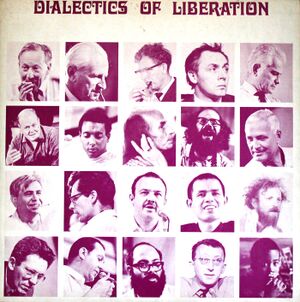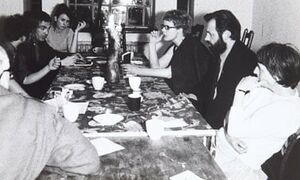Double Bind's Double life: Difference between revisions
No edit summary |
|||
| Line 1: | Line 1: | ||
==THE DOUBLE-LIFE OF THE DOUBLE-BIND== | ==THE DOUBLE-LIFE OF THE DOUBLE-BIND== | ||
Although Gregory Bateson will continue to be influential in the fields of psychoanalysis and psychiatry – particular as one of the main inspiration for R.D. Laing’s “anti-psychiatry” movement in the 1960s – Bateson, had always had an ambiguous relationship with psychoanalysis and psychiatry. He left the field in 1961 to pursue research into octopus communication (Bateson held that octopi are capable of communicating abstractly). Following this, in 1962, Bateson joined John C. Lilly’s dolphin communication centre in the Virgin Islands.<ref> With a grant from the National Science Foundation Bateson studied the coding of analogic–nonverbal–signals in octopi. In 1962 Bateson took up a research position at John C. Lilly’s dolphin communication centre in the Virgin Islands. .See Lipsit p233</ref> | Although Gregory Bateson will continue to be influential in the fields of psychoanalysis and psychiatry – particular as one of the main inspiration for R.D. Laing’s “anti-psychiatry” movement in the 1960s – Bateson, had always had an ambiguous relationship with psychoanalysis and psychiatry. | ||
He left the field in 1961 to pursue research into octopus communication (Bateson held that octopi are capable of communicating abstractly). Following this, in 1962, Bateson joined John C. Lilly’s dolphin communication centre in the Virgin Islands.<ref> With a grant from the National Science Foundation Bateson studied the coding of analogic–nonverbal–signals in octopi. In 1962 Bateson took up a research position at John C. Lilly’s dolphin communication centre in the Virgin Islands. .See Lipsit p233</ref> | |||
Double-bind theory continued to be applied in practice as a diagnostic tool and continued to be applied within family-group therapy. | Double-bind theory continued to be applied in practice as a diagnostic tool and continued to be applied within family-group therapy. | ||
In 1977, returning to the subject of the double-bind for | In 1977, returning to the subject of the double-bind for the major psychiatric conference, Beyond the Double Bind <ref> Cited in Lipset: Beyond the Double-bind, New York City, which was sponsored by the South Beach Psychiatric Center, of Staten Island. Those attending included Gregory Bateson, Milton M. Berger, M.D, John Weakland, Murray Bowen, M.D., and Carl A. Whitaker, M.D., Albert E. Schefflin, M.D., and Lyman C. Wynn, M.D. Lipset p. p.294</ref> Bateson expressed regret that the double-bind had been taken so literally and was frustrated by the oversimplistic applications afforded to the double-bind theory. He pointed out: “Double bind communication […] was a class of behavior not behavior itself and therefore was not quantifiable.” […] "You cannot count the number of double binds in a sample of behavior, just as you could not count the number of jokes in a comedian’s spiel or the number of bats in an inkblot." <ref>Cited in Lipset: Gregory Bateson: "The birth of a matrix or double bind and epistemology, " in Beyond the Double Bind,p. 41.</ref> | ||
For Bateson the double-bind addressed epistemological questions which centred on the relationship between the name and that which is named; these elements are organised within a recursive structure, the double-bind is only useful insofar as it allows one to recognise that all communication is structured in this way. | For Bateson the double-bind addressed epistemological questions which centred on the relationship between the name and that which is named; these elements are organised within a recursive structure, the double-bind is only useful insofar as it allows one to recognise that all communication is structured in this way. | ||
Revision as of 16:15, 18 September 2020
THE DOUBLE-LIFE OF THE DOUBLE-BIND
Although Gregory Bateson will continue to be influential in the fields of psychoanalysis and psychiatry – particular as one of the main inspiration for R.D. Laing’s “anti-psychiatry” movement in the 1960s – Bateson, had always had an ambiguous relationship with psychoanalysis and psychiatry.
He left the field in 1961 to pursue research into octopus communication (Bateson held that octopi are capable of communicating abstractly). Following this, in 1962, Bateson joined John C. Lilly’s dolphin communication centre in the Virgin Islands.[1] Double-bind theory continued to be applied in practice as a diagnostic tool and continued to be applied within family-group therapy.
In 1977, returning to the subject of the double-bind for the major psychiatric conference, Beyond the Double Bind [2] Bateson expressed regret that the double-bind had been taken so literally and was frustrated by the oversimplistic applications afforded to the double-bind theory. He pointed out: “Double bind communication […] was a class of behavior not behavior itself and therefore was not quantifiable.” […] "You cannot count the number of double binds in a sample of behavior, just as you could not count the number of jokes in a comedian’s spiel or the number of bats in an inkblot." [3]
For Bateson the double-bind addressed epistemological questions which centred on the relationship between the name and that which is named; these elements are organised within a recursive structure, the double-bind is only useful insofar as it allows one to recognise that all communication is structured in this way.
Bateson: “The matrix, after all, is an epistemology, and specifically it is a recursive epistemology; at the same time, it is an epistemology of recursiveness, an epistemology of how things look, how we are to understand them if they are recursive, returning all the time to bite their own tails and control their own beginnings.” [4]
In cyberneticists feedback creates a homeostatic system, the particular outcomes of that system are not determined. Bateson’s approach to therapy reflected this point, each session would be defined by the particular context, allowing for a performative response to particular circumstances. By 1977 Bateson was repelled by the idea that the double-bind could be a therapy which promised quantifiable results, at the Beyond the Double-bind conference he stated: “ "I'm not very happy at feeling myself the father of the unsaid statement that 'double bind is a theory of therapy.' I do not think it is or was." [5]
Despite Bateson’s protestations, throughout the 1960s the double-bind found its practitioners as a theory and as a therapy. In the late 1960s and early 1970s, video increasingly became as the mediator within individual and group sessions and Bateson’s ideas remained central. Bateson's influence on the counterculture continued to grow, as a presence in Radical Software (as a media-ecologist) and as a key inspiration for Stewart Brand's Co-evolutionary Quarterly (1975).
CYBER-NARCOTICS

They are playing a game
They are playing at not playing a game. If I show them I see they are I
shall break the rules and they will punish me.
I must play their game of not seeing I see the game.
R.D Laing Knots I (1970)[6]
The ease with which the practice of video therapy shifted from the clinical context into lived cultural experience is a testament to the protean quality of cybernetic discourse. A similar cultural shift occurred when the centre of the "anti-psychiatry" movement Kingsley Hall, in London became a countercultural testing ground which proposed alternative ways of living which could be applied beyond the walls of the institution. It was within this culture, the central figure of which was the psychoanalyst R.D Laing, that counterculture summit, Dialectics of Liberation (1967), which brought together the intellectual leaders of the counterculture (including Gregory Bateson, Allen Ginsberg and William Burroughs) was staged [continue]

[...] The tendency to understand video as a medium of self-knowledge, and knowledge of context, crossed into the counterculture automatically.
R.D. Laing's early research in which medical staff worked alongside patients . ... which led to the residential treatment centre Kingsley Hall the "anti-psychiatry" movement...
Knots is curiously "Batsonian" because it deals poetically with the double-bind (without explicit reference to Whitehead or Russell)...
- ↑ With a grant from the National Science Foundation Bateson studied the coding of analogic–nonverbal–signals in octopi. In 1962 Bateson took up a research position at John C. Lilly’s dolphin communication centre in the Virgin Islands. .See Lipsit p233
- ↑ Cited in Lipset: Beyond the Double-bind, New York City, which was sponsored by the South Beach Psychiatric Center, of Staten Island. Those attending included Gregory Bateson, Milton M. Berger, M.D, John Weakland, Murray Bowen, M.D., and Carl A. Whitaker, M.D., Albert E. Schefflin, M.D., and Lyman C. Wynn, M.D. Lipset p. p.294
- ↑ Cited in Lipset: Gregory Bateson: "The birth of a matrix or double bind and epistemology, " in Beyond the Double Bind,p. 41.
- ↑ Cited in Lipset: Gregory Bateson: "The birth of a matrix or double bind and epistemology, " in Beyond the Double Bind, p. 41.
- ↑ Cited in Lipset: J. Haley, "Ideas which handicap therapists," in Beyond the Double Bind, pp. 65-80.
- ↑ R.D Lang Knots p.1 Penguin 1971